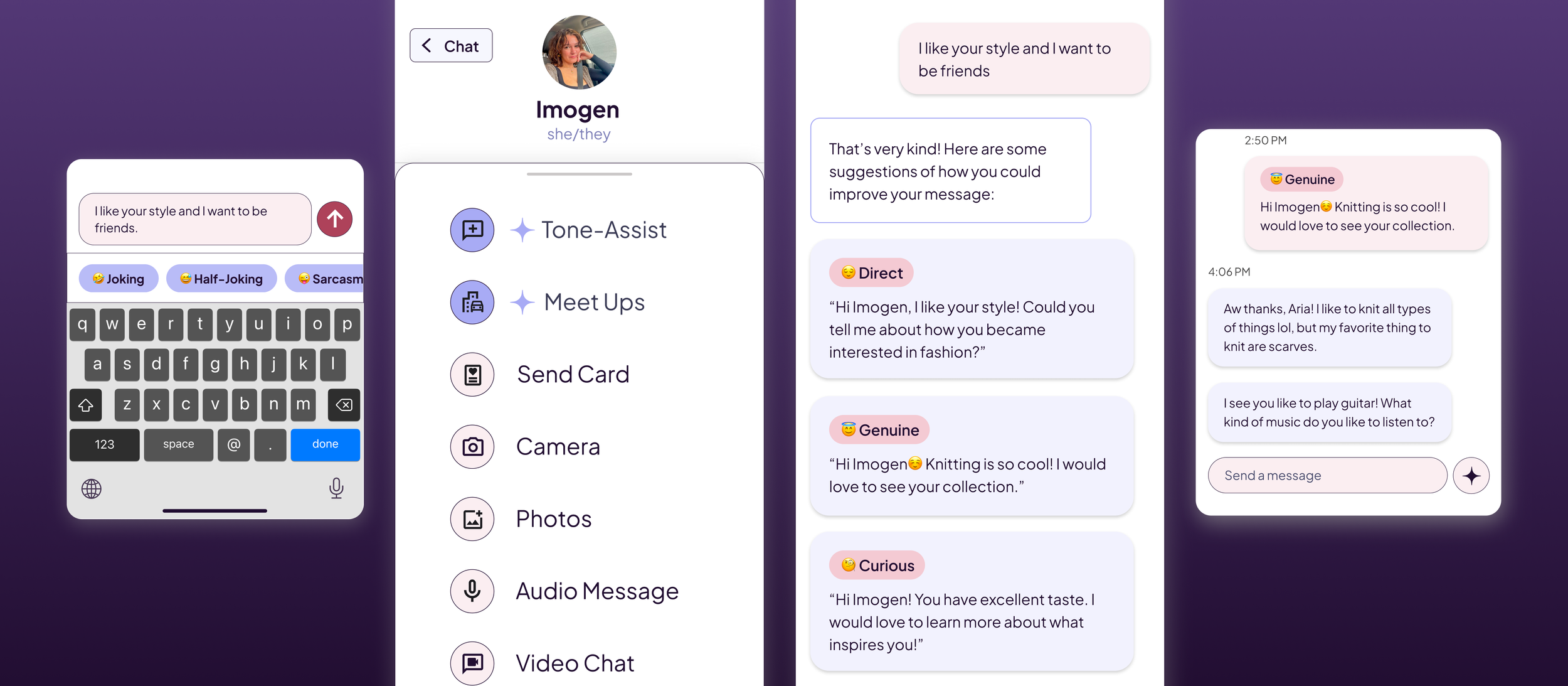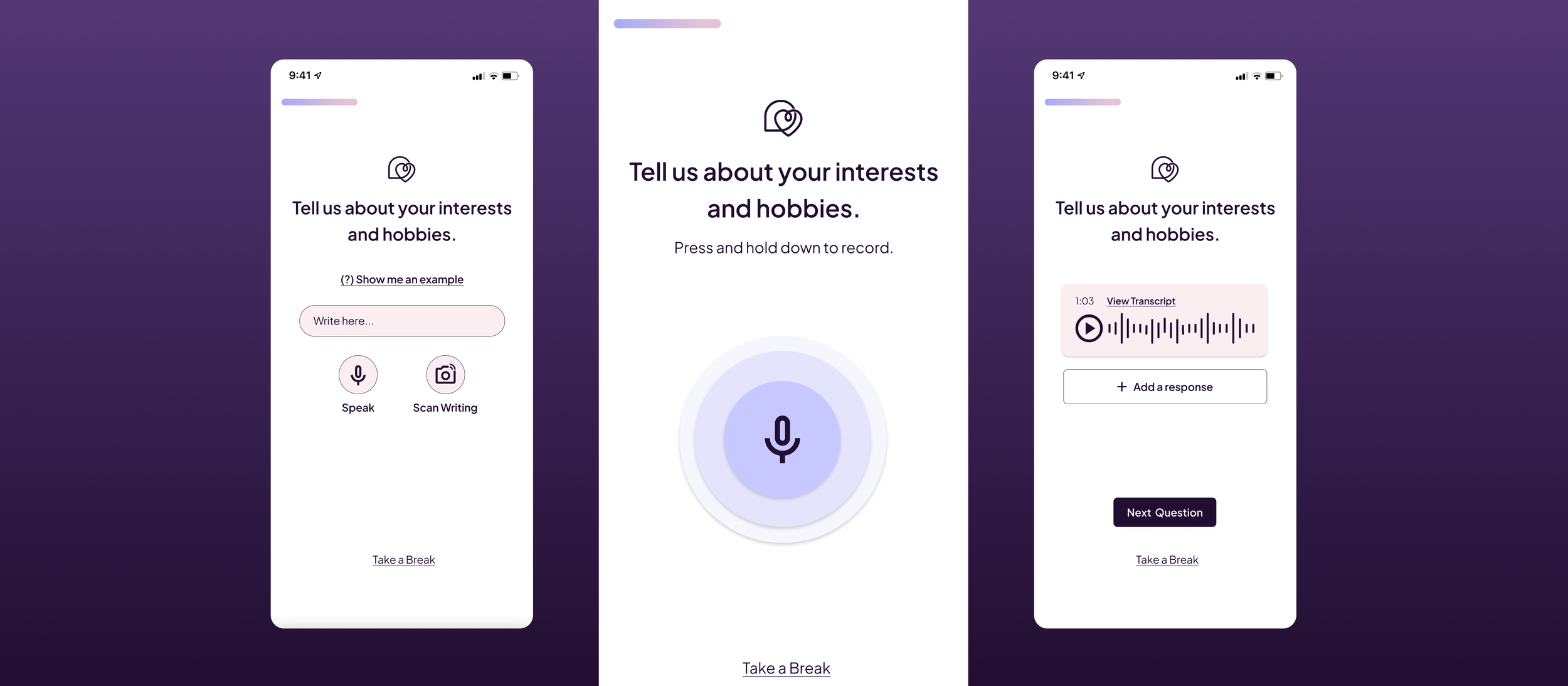
Product Design, UX, Accessibility Focus
October - December 2023
Candor: Friendship and Dating for Neurodivergent Individuals
Scroll ↓
Candor is an individual capstone project created as part of an accessibility design Studio at NC State, with IBM Mentorship. This project explores the challenges that individuals with autism face in social and romantic relationships, specifically in meeting and connecting with other neurodivergent people.
SUMMARY
TIMELINE
October-November 2023
ROLE
Product Designer, UX Designer, Accessibility Designer
SKILLS
User Journey Mapping, Storyboarding, Wireframing,
TOOLS
Figma, Miro, Adobe Illustrator
As a participant in a senior design studio featuring mentorship from IBM on accessibility, I undertook the task of designing a tool aimed at alleviating challenges encountered by individuals with disabilities through the use of artificial intelligence. I specifically directed my efforts toward addressing autism-related challenges because I am interested in fostering inclusive environments for those facing unseen obstacles.
Create an app to facilitate interpersonal connections for individuals with autism, addressing a common pain point in their social interactions.
DESIGN CHALLENGE
DESIGN SOLUTION
Candor: Fostering meaningful relationships by pairing neurodivergent people with shared interests and values while leveraging AI to reduce social anxiety and empower self-expression.
USER INTERVIEWS
Interview takeaways: Unaccommodating sensory, social, and working worlds.
I conducted three user interviews: a young adult with autism, an expert at the Autism Society of North Carolina, and an occupational therapist at UNC.
A few common themes stood out, which helped inspire and shape the idea for Candor:
There is a gap in access to adult services and employment opportunities
Young adults with autism are often barred from opportunities to explore dating despite desiring the connection and intimacy
Young adults struggle with dating partially because it requires abstract communication
SECONDARY RESEARCH & BENCHMARKING
Relationships are essential for the well-being of those with autism; they are more likely to suffer from feelings of isolation.
Despite tending to have fewer friendships than their neurotypical peers, many autistic people describe feelings of comfort and ease with other autistic people. Sustained camouflaging and masking around neurotypical peers can contribute to mental distress, which is exacerbated by unaccommodating physical and sensory environments—this desire for connection inspired my idea to benchmark existing online matching services.
PERSONA DEVELOPMENT
Designed for Aria, an autistic woman who desires to make neurodiverse friends in her area.
Aria is an aspiring author. Since she completed college, she has continually been lonely and deprived of social connections. She has attended some community events but frequently finds herself feeling drained and overstimulated after masking to fit in with neurotypical strangers. She is single and would be open to meeting someone but is not actively seeking a relationship. Aria wants to find people with whom she can be her most authentic self.
Hopes:
Make more friends
Have a greater social network and community
Go outside of her comfort zone
Eventually find a romantic partner
Painpoints:
Overwhelmed by dating profile curation and small talk
Easily overwhelmed by social gatherings
Struggles with social anxiety
Has difficulty interpreting social cues
Scenario Video: Aria, who desires to make neurodiverse friends in her area, downloads Candor. She makes a profile and begins a conversation with a potential friend.
Can AI enhance user experience by minimizing communication barriers? Creating a flexible, low pressure dating/friendship app.
IDEATE - INFORMATION ARCHITECTURE
I focused my information architecture and ideation on connecting people with compatible interests and preferences, as well as AI's role in dissolving barriers people with disabilities may face in describing themselves. To reduce the strain on a user having to find the perfect words for their profile, they have the flexibility to speak, type, or write freely about themselves with guided prompts, and AI assists in profile generation.
How do I create a solution that works for the diverse and unique needs and preferences of people with autism?
IDEATE - STORYBOARDING AND USER JOURNEY
I learned early on in my research that designing for people with autism is a challenge because what works for one individual could be a roadblock for another. So, in my ideation, I wanted to create solutions that allow for flexibility in use with respect for privacy and conscientiousness surrounding safety.
AI Profile Generator: Prompts users with a few key questions that they can respond to openly by typing, talking, or writing.
KEY FEATURES
Profile Prompts with AI Tone Assist: AI guides users as they craft appropriate responses via video, text, or voice.
AI Meetup Suggestions: Personalized date suggestions based on shared interests, preferences, and accommodations.
Personal Interest Cards: AI generated cards of the user’s interests that can be customized and shared with other people.
Tone Indicators in Messaging: AI assists users as they craft messages by providing response suggestions using tonal descriptions.
PERSONAL REFLECTION
Designing for people with disabilities is beneficial for everyone.
Through this design process, I learned that creating multimodal and flexible methods can often benefit users of all different abilities. Each person’s experience with a disability is unique, and it’s important not to generalize. Particularly with ADHD and autism, it is challenging to accommodate all users because there is such a diverse variety of how each person’s brain functions. This consideration led me to another design takeaway: to uplift neurodivergent strengths rather than shift the design to fit a neurotypical framework. Our society tends to disadvantage people with disabilities because systems and designs are created to exclude specific demographics. Instead of viewing disabilities as a problem that must be solved, why don’t we create designs that actively include users of different abilities within the design process? The end products are more enriching, innovative, and user-friendly for all.
Future Considerations: Privacy and security to ensure a safe and successful user experience.
From the beginning of this project, I realized that if this product were implemented publicly, safety measures would need to be carefully considered to ensure that users are protected. As a particularly vulnerable population, this would be of the utmost importance. This was a problem beyond the scope of this project. Still, if I continue in the future, I would like to explore how education about appropriate online social and relational etiquette could be included within the application. Another idea I would have liked to explore is including safe, public all-access community events.












